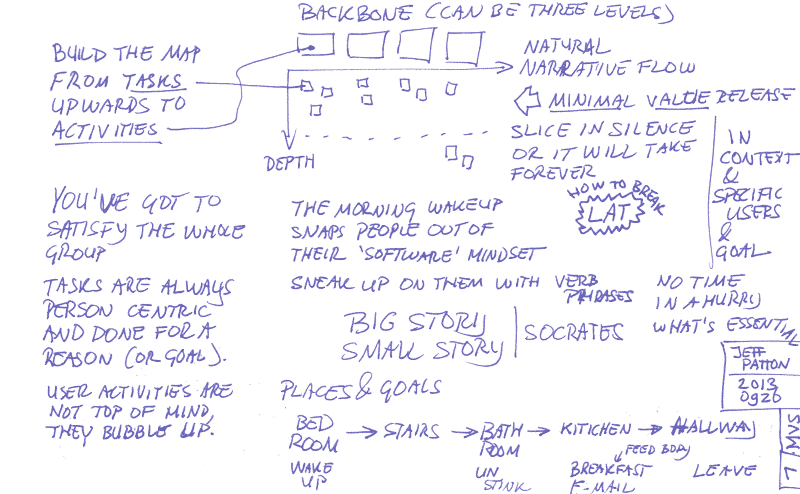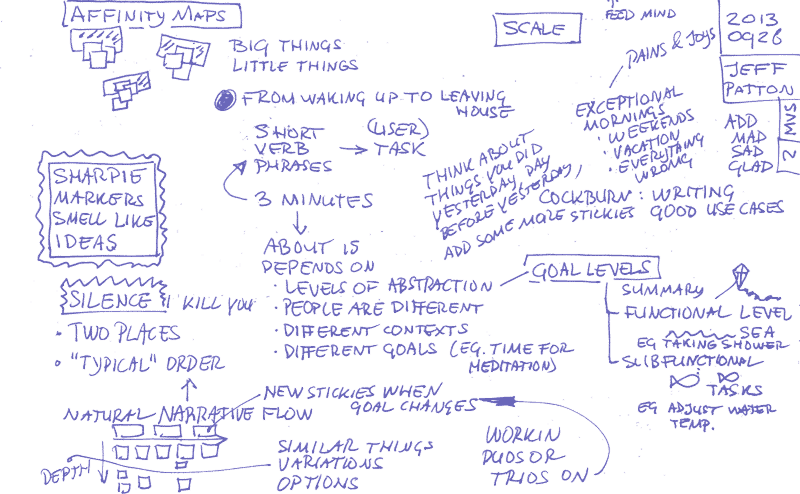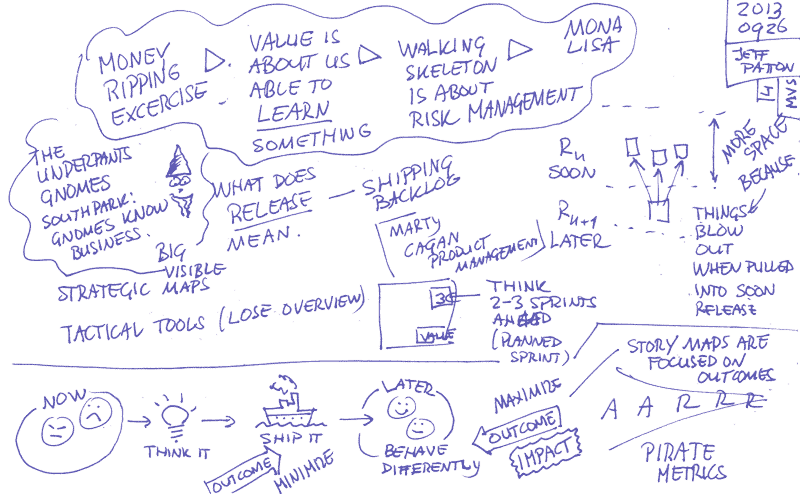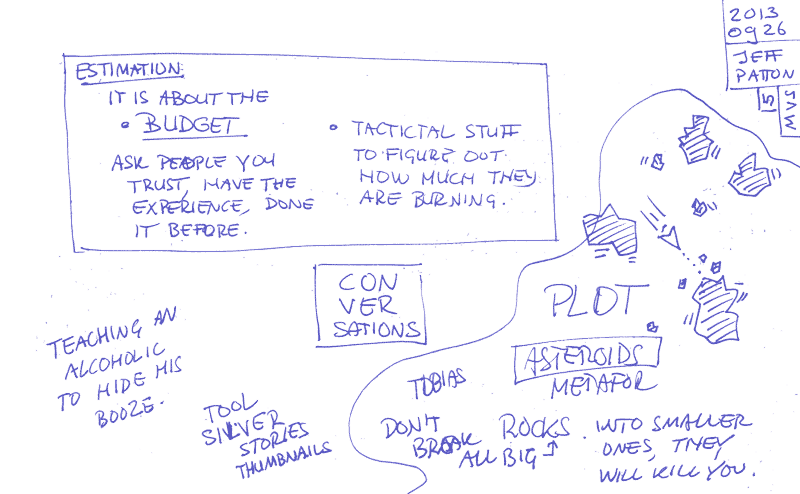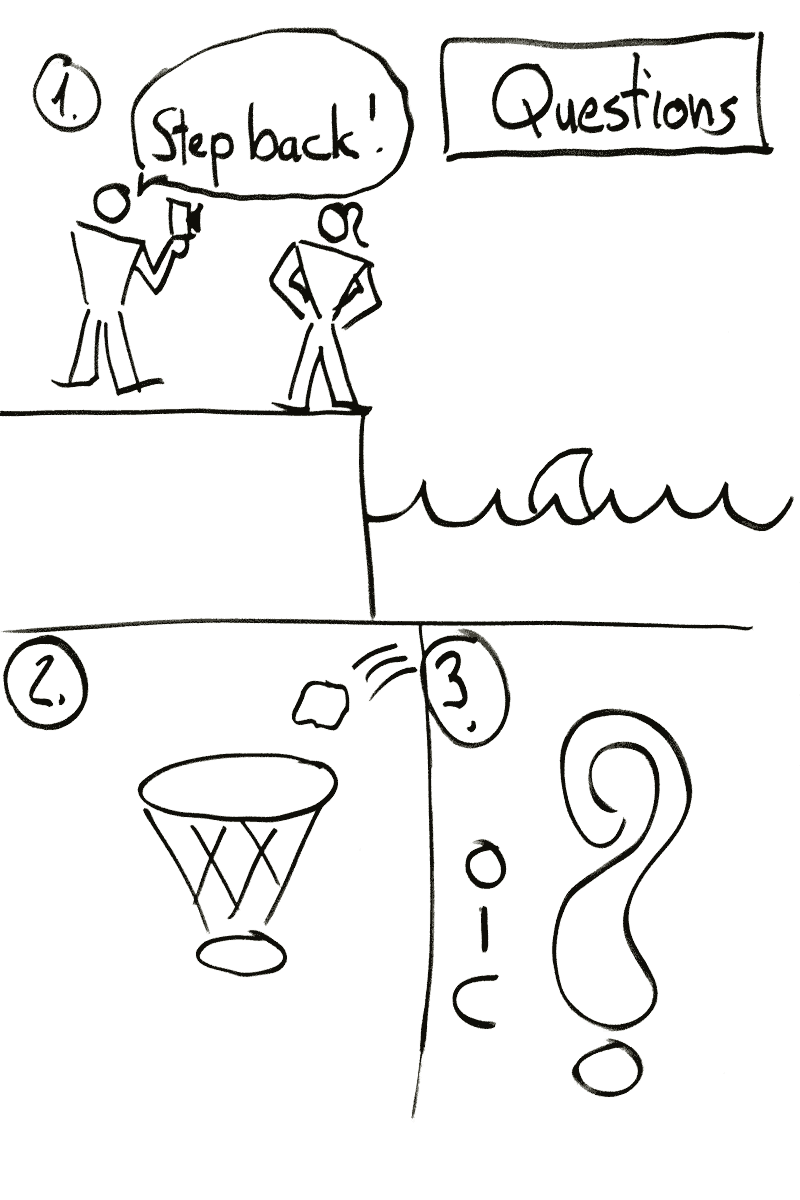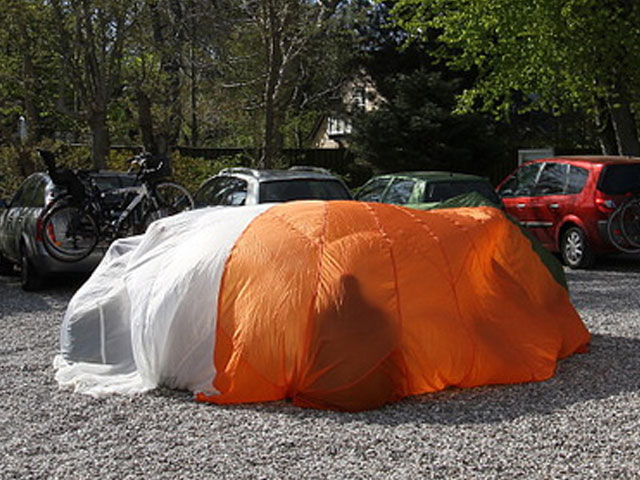Martien’s notes from the Kanban Coaching Professional Masterclass with David J. Anderson in October 2013 in the Double Tree Hotel, Amsterdam.
—-
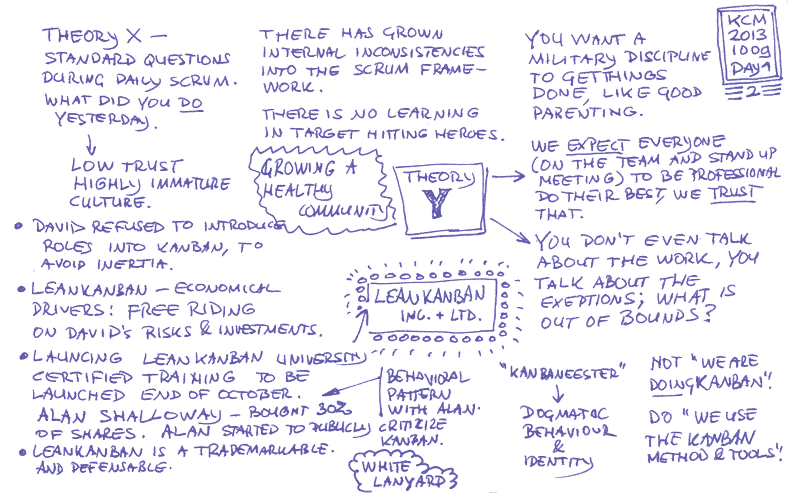
—-
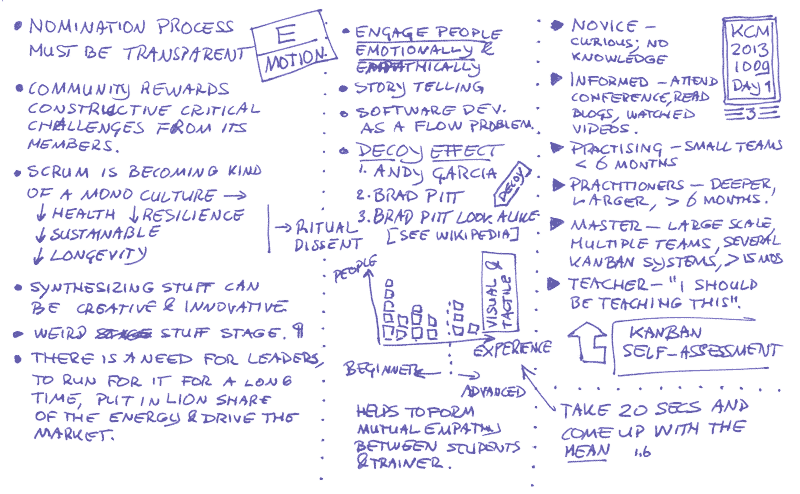
—-

—-
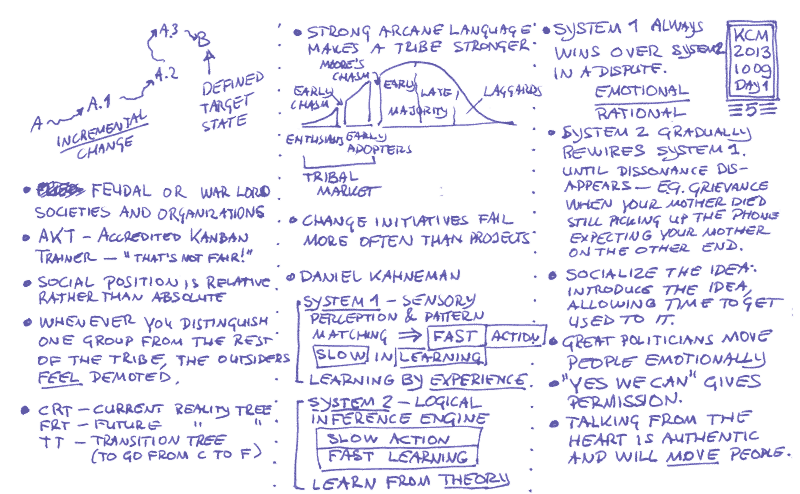
—-

—-
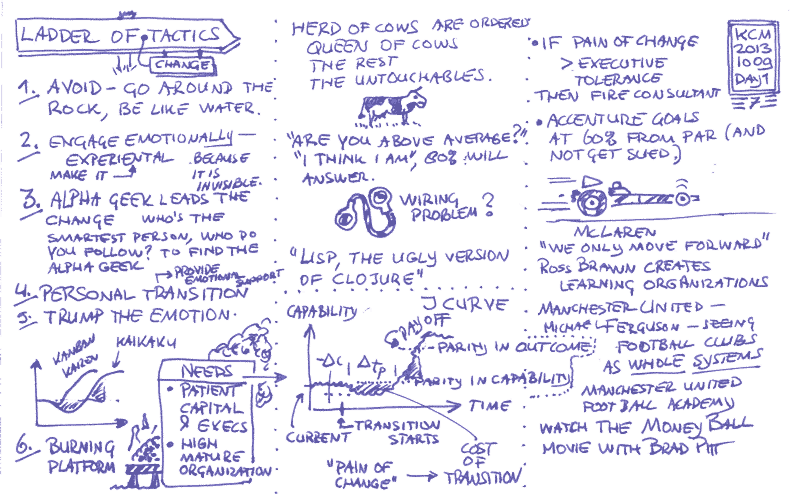
—-
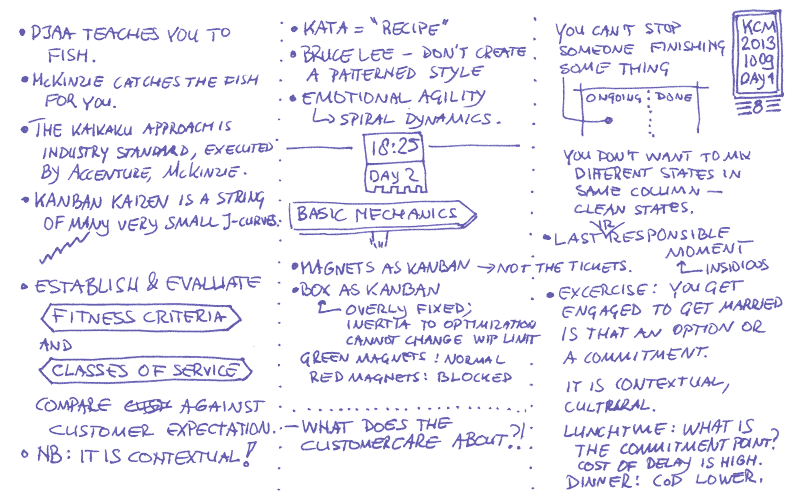
—-
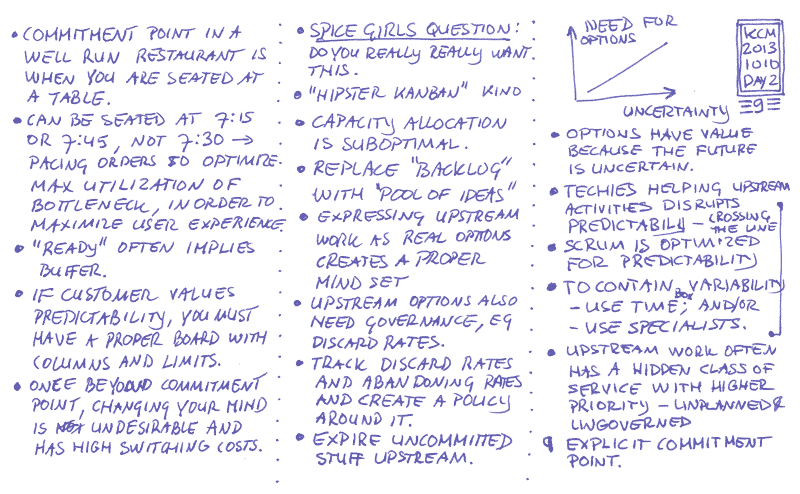
—-
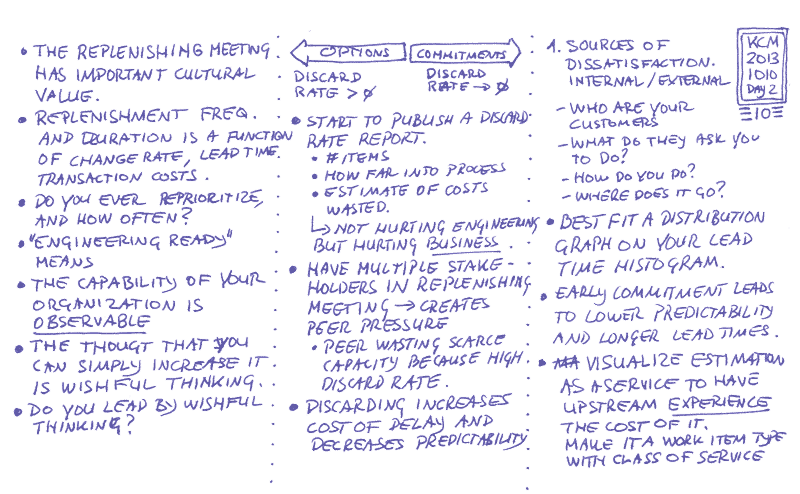
—-

—-
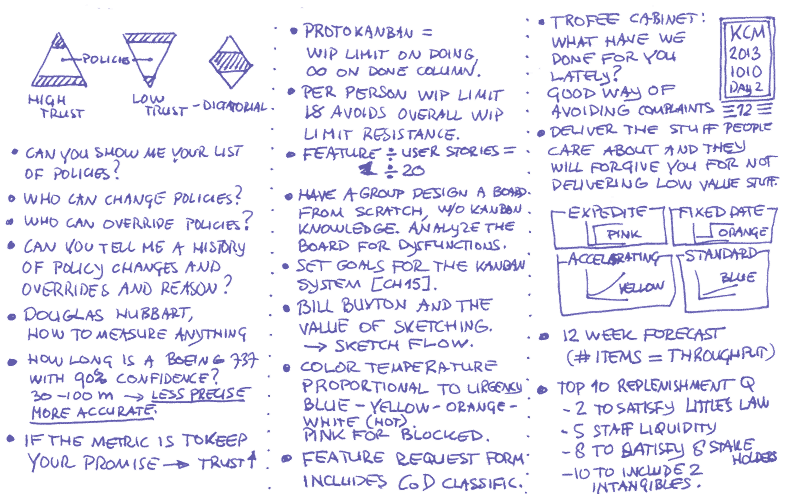
—-

—-
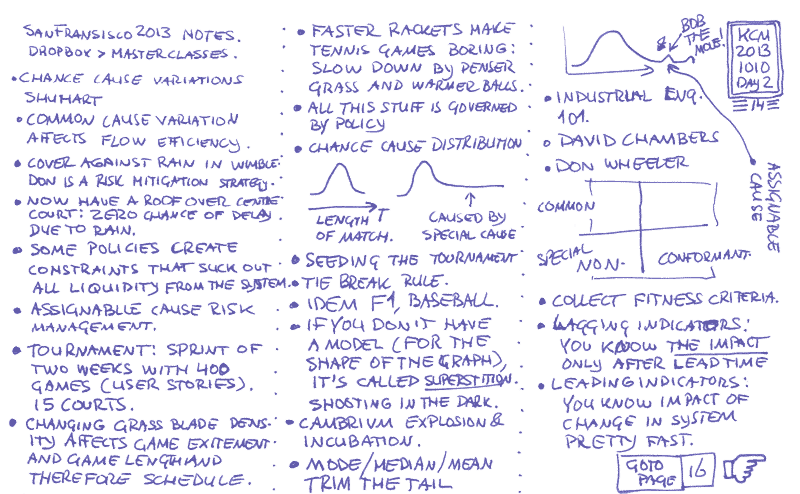
—-
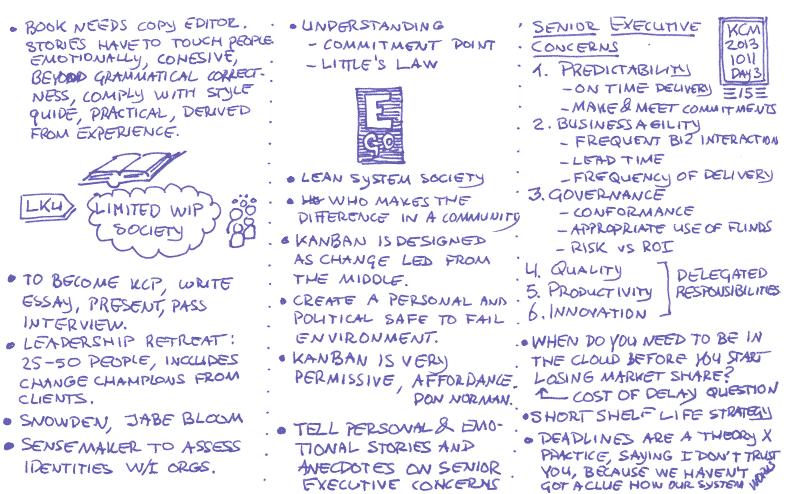
—-

—-

—-

Category: english
Uitsluitend English.
Jeff Patton visits Xebia
Kudos to Olav Maassen for inviting Jeff ‘User Story Mapping’ Patton over to Xebia last Thursday.
Jeff mentioned a couple of resources:
- Tools For Agile » Silver Stories
- Pirate Metrics
- Co-Makers
- The Story Fabricator
- Dennis Stevens » Capability Mapping
Martien’s notes…
Everyone is creative, by nature. Just unsuppress it by following Albert Bandura’s ‘Guided Mastery’.
Clear goal, simple rules
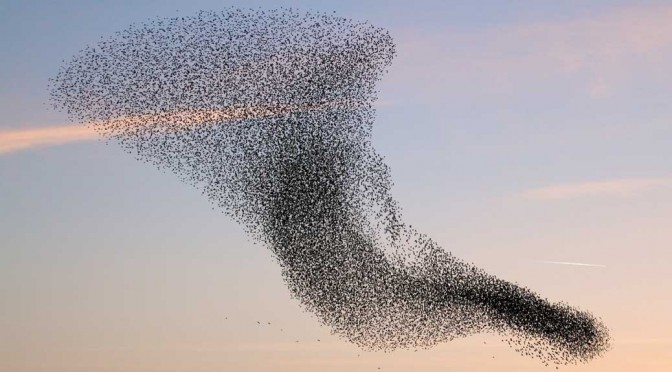
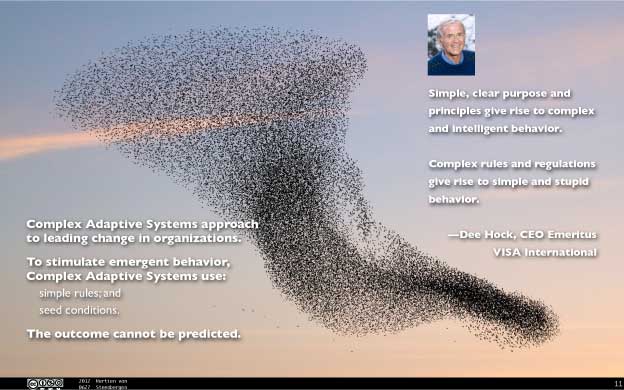
Simple, clear purpose and principles give rise to complex and intelligent behavior.
Complex rules and regulations give rise to simple and stupid behavior.
Dee Hock, CEO Emeritus VISA International
From team charter:
- Team—A group of people or animals linked in a unity of purpose.
- Self-organization—The tendency of an open system to generate new structures and patterns based on its own internal dynamics. Organization design emerges from the interactions of the agents in the system; it is not imposed from above or outside. Facilitating Organization Change: Lessons from Complexity Science
Three factors influence the patterns that emerge:
- The container sets the bounds for the self-organizing system. It defines the “self” that organizes.
- Significant differences determine the primary patterns that emerges (power, level of expertise, gender, …).
- Transforming exchanges form the connections between system agents.
Just as a person needs time and space to incubate thoughts before a new Idea can emerge, a system needs a bounded space for the emergence of new patterns. Patterns imply structure, organization. Self-organizations gives you order for free. Effortless organization? don’t just do something, stand there!
Life is a serious game. life is a broccoli.

Fused
Agile Management » David J. Anderson » Lean Risk Management—Options, Liquidity & Hedging Risk using Kanban Systems (ppt) and the video below on a single big visible chart (A2-sized).
Changes:
- David uses ‘risk profiles’ to find out what to pull next. If
success + risk = 1you can invert a ‘risk profile’ into a ‘success profile’ if you will. - Chart uses a ”’polar chart”’ rather than a radar chart.
Usage:
- Create success profile on an index card for every option you want to execute soon.
- Put it into corresponding swim lane, honoring any work in progress limit.

Highlights from ”Past the Tipping Point: The Persistence of Firefighting in Product Development” by Nelson Repenning, Paulo Gonçalves, and Laura Black.
Putting out fires is not improvement. Finding a point out of control, finding the special cause and removing it, is only putting the process back to where it was in the first place. It is not improvement of the process.
—W Edwards Deming
Unplanned allocation of resources to fix problems can switch the entire company to epidemical firefighting and organizational pathology. Even a temporary increase in workload can initiate the firefighting dynamic and cause a permanent decline in system performance and health.
Firefighting:
- snaps into place when pushed beyond the tipping point or threshold
- drives out disciplined and more structured (development) processes, becoming the (development) process instead
- can significantly degrade an organization’s ability to create high quality products in a stable, predictable, sustainable and resilient way
- is a self-reinforcing syndrome with a tipping point, and is, therefore, fragile
- is hard to recognize (its symptoms), causing corrective action to be taken too late
- comes very naturally
Likely goals:
- be an innovative, competitive, stable, predictable, sustainable and resilient organization;
- stay clear of the tipping point when you are on its productive and innovative side;
- get close to the tipping point a.s.a.p. when you are in firefighting mode, and then nimbly nudge it over;
To avoid firefighting to become a company-wide disease:
- Discourage, ignore or penalize heroism and heroic behavior.
- Use a boom buffer with a clear policy and managerial impact when excepted.
- Keep current tools and technology, avoiding time needed to invest in learning them that (temporary) lowers productivity
- Have a laser focus on top quality for product, process and people as lower quality will push the organization into the death spiral of declining competitiveness, reduce revenue and future innovation.
- Do root cause analysis and resolution of the top problems. Just postponing problematic projects does not prevent the spreading of firefighting, it just pushes them downstream to bite you next year, and probably harder.
- Perform aggregate resource planning to prevent fires.
- Reduce the number of parallel products or projects—so bring focus.
- Avoid full utilization of human assets. Cherish slack resources as a buffer against uncertainties (also see boom buffer).
- Aggressively cancel failing projects early.
- Revisit the product plan instead of trying to catch up.
- Do not rent or steal people from or lend people to other parts of the organization as it might start a fire.
- Reduce workload effectively to stabilize the system, e.g. by skipping a model year altogether.
- Do fewer projects and cancel more.
- Put a strict (Work In Progress or WIP) limit on many or all parts of the value stream, and use those to maximize flow.
- Undercommit and overperform.
- Uphold a strict policy of only accepting finished, done work. Mercilessly reject any unfinished work and loose ends.
- Perform thorough up-front work. Make policies and admission criteria to pull something into the next step crystal clear. This will:
- increase the likelihood that the item will get done in time;
- reduce or avoid the need to cancel it later;
- make owners face strong incentives to invest in the early phase activities and develop clever ways to demonstrate the efficacy of a proposed product far in advance of its detailed design.
All this resonates with agile, scrum, lean, and kanban.
The BOSCARD can be seen as an acronym for the A3 and be used as a strategic planning tool used to provide the terms-of-reference for new projects:
- Background—Provide background information that includes the reasons for creating the project and mentions the key stakeholders who will benefit from the project result.
- Objectives—Describe the project goals and link each of them with related, SMART project objectives.
- Scope—Provide a high-level description of the features and functions that characterise the product, service, or result the project is meant to deliver. Be explicit about what is in and what is out of scope.
- Constraints—Identify the specific constraints or restrictions that limit or place conditions on the project, especially those associated with project scope.
- Assumptions—Specify all factors that are, for planning purposes, considered to be true. During the planning process these assumptions will be validated.
- Risks—Outline the risks identified at the start of the project. Include a quick assessment of the significance of each risk and how to address them.
- Deliverables—Define the key deliverables the project is required to produce in order to achieve the stated objectives.
Include the initiative’s name, its strategic fit, date raised, sponsor, and lead.
Make all stakeholders understand the BOSCARD and make sure you have everyone’s consent before investing even the first euro on this initiative. Woithout everyone’s consent, some expectations will not be met.
Consider replacing your PIDs with BOSCARDs. Decision-makers, scarce on time, will love it.
The BOSCARD is thought to have originated with consulting company Cap Gemini in the 1980s.
Joseph Perline’s 3 Questions
LA Times Gets Hits with Wiki Stick:
(Update: somewhat obvious April Foolery!) News of a very surprising and innovative move in journalism: The former Los Angeles Times has transitioned to become The Los Wikiless Timespedia, ‘continuously updated by the fine people of Los Angeles and the World.’
‘We tried basically all the gimmicks we know,’ said new Editor-in-Chief Tony Cahter, recently promoted from the depleted typesetting staff. ‘Different fonts. Moving Marmaduke to the front page. Everything.’
The wiki news system allows readers to enter and edit articles as they please.
‘If you see an article you don’t like or don’t agree with, just change it. Then if the next person doesn’t like that, they can change it back. We call it an editocracy.’
At least, that’s what the site said a few minutes ago. You’d better check it out yourself if you want to see what it says now, or if you want to contribute.
Via Grand Text Auto.
Time in my view is the continuity of memory using the ego as an internal reference point. When we break the barrier of ego, the self-image, we break the barrier of time.
So time is the separation that occurs when there is the differentiation of our consiousness into observer, process of observation and that which is observed. And then how we measure our observations through the creation of an artificial observer gives us the experience of time.
In fact, there is no time—there is only eternity. The measurement of eternity is symbolized as the measurement of time. And, of course, how we metabolize our experience of time, is the way our bodies undergo entropy.
So if we are running out of time, we literally run out of time biologically. People who say “I’m running out of time”, they have speeded up biological clocks. Faster heart rates [inaudible]. And they drop dead of premature heart attacks. They run out of time.
If you are in love time stops. The intoxication of love allows you to experience unity consciousness and timelessness. If you are bored, time drags. And entropy is the metabolism of time.
I have a lot more to say about the nature of time, but I’m running out of time. So, see you next time, or let me know what you think.
Source: How to Be Timeless Right This Moment ~ Deepak Chopra.
Prachtig interview met [http://aardnoot.nl/Amit_Gosmwami Amit Goswami] over [http://www.wie.org/j11/goswami.asp Scientific Proof of the Existence of God]. Voor mij is de ”’essentie”’ nog steeds:
:Consciousness matters™—and that’s all that matters
En dat kan je dus ”’heel letterlijk”’ nemen. Zelfs het woord ”heel” uit de vorige zin krijgt daardoor voor mij meer waarde.
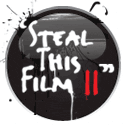 Steal This Film [part one] is a spectacular documentary on Sweden’s piracy movement — The Pirate Bay BitTorrent site, The Pirate Bureau think-tank and The Pirate Party, a political party. Steal This Film ingeniously combines Hollywood footage, scare-interviews with Hollywood execs, Hollywood anti-piracy PSAs and footage of interviews with Swedish pirates, politicians and people on the street.
Steal This Film [part one] is a spectacular documentary on Sweden’s piracy movement — The Pirate Bay BitTorrent site, The Pirate Bureau think-tank and The Pirate Party, a political party. Steal This Film ingeniously combines Hollywood footage, scare-interviews with Hollywood execs, Hollywood anti-piracy PSAs and footage of interviews with Swedish pirates, politicians and people on the street.
Source: [http://www.boingboing.net/2006/08/23/steal-this-movie-doc.html Steal This Movie: documentary on Swedish piracy movement] via [http://www.p2pfoundation.net/Steal_This_Film Peer-to-Peer Foundation].
 De Amerikaanse National Science Foundation verzamelt met behulp van een jaarlijks wedloop [http://nsf.gov/news/special_reports/scivis/ prachtig wetenschappelijk beeldmateriaal].
De Amerikaanse National Science Foundation verzamelt met behulp van een jaarlijks wedloop [http://nsf.gov/news/special_reports/scivis/ prachtig wetenschappelijk beeldmateriaal].
